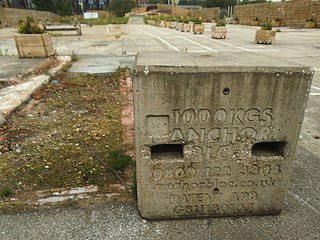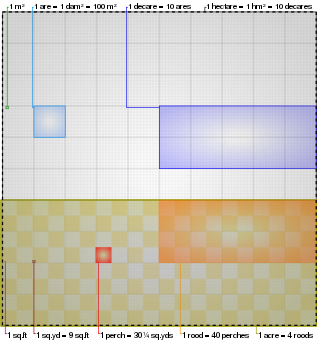
A centimetre or centimeter is a unit of length in the International System of Units (SI), equal to one hundredth of a metre, centi being the SI prefix for a factor of 1/100. Equivalently, there are 100 centimetres in 1 metre. The centimetre was the base unit of length in the now deprecated centimetre–gram–second (CGS) system of units.

The kilogram is the base unit of mass in the International System of Units (SI), having the unit symbol kg. It is a widely used measure in science, engineering and commerce worldwide, and is often simply called a kilo colloquially. It means 'one thousand grams'.

The litre or liter is a metric unit of volume. It is equal to 1 cubic decimetre (dm3), 1000 cubic centimetres (cm3) or 0.001 cubic metre (m3). A cubic decimetre occupies a volume of 10 cm × 10 cm × 10 cm and is thus equal to one-thousandth of a cubic metre.

The metre is the base unit of length in the International System of Units (SI).
Mega is a unit prefix in metric systems of units denoting a factor of one million (106 or 1000000). It has the unit symbol M. It was confirmed for use in the International System of Units (SI) in 1960. Mega comes from Ancient Greek: μέγας, romanized: mégas, lit. 'great'.

The micrometre as used by the International Bureau of Weights and Measures; SI symbol: μm) or micrometer, also commonly known by the non-SI term micron, is a unit of length in the International System of Units (SI) equalling 1×10−6 metre ; that is, one millionth of a metre.
A nautical mile is a unit of length used in air, marine, and space navigation, and for the definition of territorial waters. Historically, it was defined as the meridian arc length corresponding to one minute of latitude at the equator. Today the international nautical mile is defined as 1,852 metres. The derived unit of speed is the knot, one nautical mile per hour.
The International System of Units, internationally known by the abbreviation SI, is the modern form of the metric system and the world's most widely used system of measurement. Established and maintained by the General Conference on Weights and Measures (CGPM), it is the only system of measurement with an official status in nearly every country in the world, employed in science, technology, industry, and everyday commerce.
A metric prefix is a unit prefix that precedes a basic unit of measure to indicate a multiple or submultiple of the unit. All metric prefixes used today are decadic. Each prefix has a unique symbol that is prepended to any unit symbol. The prefix kilo-, for example, may be added to gram to indicate multiplication by one thousand: one kilogram is equal to one thousand grams. The prefix milli-, likewise, may be added to metre to indicate division by one thousand; one millimetre is equal to one thousandth of a metre.

The tonne is a unit of mass equal to 1000 kilograms. It is a non-SI unit accepted for use with SI. It is also referred to as a metric ton to distinguish it from the non-metric units of the short ton and the long ton. It is equivalent to approximately 2204.6 pounds, 1.102 short tons, and 0.984 long tons. The official SI unit is the megagram, a less common way to express the same amount.

The metric system is a system of measurement that succeeded the decimalised system based on the metre, which had been introduced in France in the 1790s. The historical development of these systems culminated in the definition of the International System of Units (SI) in the mid-20th century, under the oversight of an international standards body. Adopting the metric system is known as metrication.
The kilometre, spelt kilometer in American English and Philippine English, is a unit of length in the International System of Units (SI), equal to one thousand metres. It is now the measurement unit used for expressing distances between geographical places on land in most of the world; notable exceptions are the United States and the United Kingdom where the statute mile is the main unit used.

The square metre or square meter is the unit of area in the International System of Units (SI) with symbol m2. It is the area of a square with sides one metre in length.
Nano is a unit prefix meaning one billionth. Used primarily with the metric system, this prefix denotes a factor of 10−9 or 0.000000001. It is frequently encountered in science and electronics for prefixing units of time and length.
Hecto is a decimal unit prefix in the metric system denoting a factor of one hundred. It was adopted as a multiplier in 1795, and comes from the Greek ἑκατόν hekatón, meaning "hundred". In 19th century English it was sometimes spelled "hecato", in line with a puristic opinion by Thomas Young. Its unit symbol as an SI prefix in the International System of Units (SI) is the lower case letter h.
The decimetre, is a unit of length in the International System of Units, equal to one tenth of a metre, ten centimetres, one hundred millimetres, and 3.937 inches.
A decametre, symbol dam, is a unit of length in the International System of Units (SI) equal to ten metres.

The hectare is a non-SI metric unit of area equal to a square with 100-metre sides (1 hm2), that is, 10,000 square meters, and is primarily used in the measurement of land. There are 100 hectares in one square kilometre. An acre is about 0.405 hectares and one hectare contains about 2.47 acres.
The angstrom or ångström is a metric unit of length equal to 10−10 m; that is, one ten-billionth (US) of a metre, a hundred-millionth of a centimetre, 0.1 nanometre, or 100 picometres. Its symbol is Å, a letter of the Swedish alphabet. The unit is named after the Swedish physicist Anders Jonas Ångström (1814–1874).

The cubic metre or cubic meter is the unit of volume in the International System of Units (SI). Its symbol is m3. It is the volume of a cube with edges one metre in length. An alternative name, which allowed a different usage with metric prefixes, was the stère, still sometimes used for dry measure. Another alternative name, no longer widely used, was the kilolitre.













